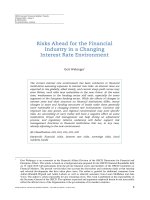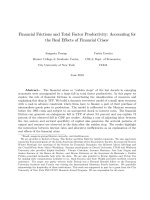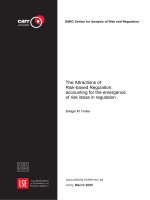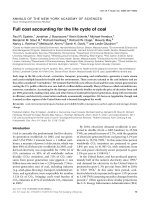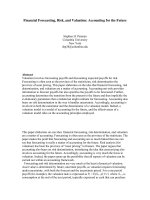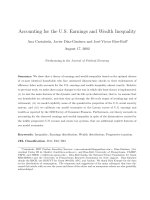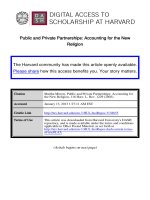Lecture Managerial Accounting for the hospitality industry: Chapter 5 - Dopson, Hayes
Bạn đang xem bản rút gọn của tài liệu. Xem và tải ngay bản đầy đủ của tài liệu tại đây (453.19 KB, 46 trang )
Chapter 5
The Statement of Cash
Flows
© 2009 John Wiley & Sons
Hoboken, NJ 07030
1
Managerial Accounting for the Hospitality Industry
Dopson & Hayes
Chapter Outline
Understanding Cash Flows
The Purpose of the Statement of Cash Flows
Sources and Uses of Funds
Creating the Statement of Cash Flows
Statement of Cash Flows Analysis
© 2009 John Wiley & Sons
Hoboken, NJ 07030
2
Managerial Accounting for the Hospitality Industry
Dopson & Hayes
Learning Outcomes
State the reason cash flows are critical to the operation
of a successful business.
Identify sources and uses of funds to assist in the
creation of a statement of cash flows.
Create a statement of cash flows using an income
statement and two balance sheets.
Analyze a statement of cash flows to better manage the
cash flows of your own business.
© 2009 John Wiley & Sons
Hoboken, NJ 07030
3
Managerial Accounting for the Hospitality Industry
Dopson & Hayes
Understanding Cash Flows
Assume, for example, that you have income from a
variety of sources.
These sources may include money paid to you from a
job, income from parents or other family members, and
interest you may earn on savings accounts.
In addition, you have living and school expenses that
must be paid.
You know that you must have enough money on hand
to pay your bills as they become due.
Having access to cash at the right time (versus having
the right amount of cash) is important to individuals. It is
also critically important to businesses.
© 2009 John Wiley & Sons
Hoboken, NJ 07030
4
Managerial Accounting for the Hospitality Industry
Dopson & Hayes
The Purpose of the Statement of Cash
Flows
The statement of cash flow shows (SCF) shows all
sources and uses of funds from operating, investing,
and financing activities of a business.
The SCF is designed to report a business’s inflows and
outflows of money affecting the cash position as well as
its beginning and ending cash and cash equivalents
balances for each accounting period.
The cash inflows and outflows of a business are of
significant importance to a business’s owners,
investors, lenders, creditors, and managers.
© 2009 John Wiley & Sons
Hoboken, NJ 07030
5
Managerial Accounting for the Hospitality Industry
Dopson & Hayes
The Purpose of the Statement of Cash
Flows
Cash on a balance sheet is considered to be a current
asset.
Cash, in this case, refers to currency, checks on hand,
and deposits in banks.
Cash is not synonymous with the term “revenue” or
“sales.”
Cash equivalents are short-term, temporary
investments such as treasury bills, certificates of
deposit, or commercial paper that can be quickly and
easily converted to cash.
© 2009 John Wiley & Sons
Hoboken, NJ 07030
6
Managerial Accounting for the Hospitality Industry
Dopson & Hayes
Sources and Uses of Funds
Sources represent inflows and uses represent outflows
of funds for the hospitality business.
When comparing assets from last period’s balance
sheet to this period’s balance sheet, decreases in
assets represent sources of funds and increases in
assets represent uses of funds.
Accumulated depreciation behaves in an opposite
manner to the other assets.
This is because depreciation is a contra asset account.
© 2009 John Wiley & Sons
Hoboken, NJ 07030
7
Managerial Accounting for the Hospitality Industry
Dopson & Hayes
Figure 5.1 Sources and Uses of Funds for Assets
Assets
Current Assets
Cash
Marketable Securities
Net Receivables
Inventories
Prepaid Expenses
Investments
Property and Equipment
Land
Building
Furnishings and Equipment
Accumulated Depreciation
Other Assets
© 2009 John Wiley & Sons
Hoboken, NJ 07030
8
Increases
Decreases
Use
Use
Use
Use
Use
Use
Source
Source
Source
Source
Source
Source
Use
Use
Use
Source
Use
Source
Source
Source
Use
Source
Managerial Accounting for the Hospitality Industry
Dopson & Hayes
Sources and Uses of Funds
Alternatively, increases in liabilities and owners’ equity
represent sources of funds and decreases in liabilities
and owners’ equity represent uses of funds.
Figure 5.2 Sources and Uses of Funds for Liabilities and Owners’ Equity
Liabilities and Owners’ Equity
Current Liabilities
Accounts Payable
Notes Payable
Other Current Liabilities
Long-Term Liabilities
Long-Term Debt
Owners’ Equity
Common Stock
Paid in Capital
Retained Earnings
© 2009 John Wiley & Sons
Hoboken, NJ 07030
9
Increases
Decreases
Source
Source
Source
Use
Use
Use
Source
Use
Source
Source
Source
Use
Use
Use
Managerial Accounting for the Hospitality Industry
Dopson & Hayes
Sources and Uses of Funds
Figure 5.3 Trick for Remembering Sources and Uses of Funds
Sources
↓ Assets*
↑ Liabilities
↑ Owners’ Equity
Uses
↑ Assets*
↓ Liabilities
↓ Owners’ Equity
*Remember that depreciation is a contra asset
account and behaves oppositely of all other assets,
so ↑ in depreciation is a source and ↓ of depreciation
is a use.
Up arrows represent “increases” and down arrows represent
“decreases.”
Assets in each column have opposite arrows from liabilities and
owners’ equity. Also, arrows in the left column are opposite of
those in the right column.
© 2009 John Wiley & Sons
Hoboken, NJ 07030
10
Managerial Accounting for the Hospitality Industry
Dopson & Hayes
Sources and Uses of Funds
If you can remember only one, you can remember all
the rest. Once you have that arrow correct, then you
can remember the directions of the other arrows. Be
careful, though!
If you get your one example backwards, then ALL of the
others are wrong! Memorize this “trick”; it will help you
immensely!
You can now put numbers to your sources and uses of
funds.
These numbers will show you increases and decreases
as shown in Figure 5.4.
© 2009 John Wiley & Sons
Hoboken, NJ 07030
11
Managerial Accounting for the Hospitality Industry
Dopson & Hayes
Steps to Calculate Sources and Uses
of Funds
1. Draw the chart shown in Figure 5.3 to help you identify sources
and uses of funds.
2. Draw up arrows ↑ and down arrows ↓ next to the balance sheets to
indicate increases and decreases in the accounts from 2009 to
2010.
3. Calculate the difference in each account from 2009 to 2010.
4. Place the difference in each account under the appropriate
Sources or Uses column. Do not calculate subtotals and totals.
5. Add the numbers in the Sources column and then add the number
in the Uses column.
6. The totals in each column should equal each other. If they do, you
have identified the correct sources and uses of funds, and you are
finished!
7. If the totals in each column do not equal each other, calculate the
difference between the columns and divide by 2. This is the
amount of your mistake.
© 2009 John Wiley & Sons
Hoboken, NJ 07030
12
Managerial Accounting for the Hospitality Industry
Dopson & Hayes
Figure 5.4 Sources and Uses of Funds for Blue Lagoon Water Park Resort
Blue Lagoon Water Park Resort
Balance Sheets
December 31, 2009 and 2010
2009
2010
Sources
Uses
Assets
Current Assets
Cash
Marketable Securities
Net Receivables
Inventories
Total Current Assets
2,370,800
4,109,600
1,655,300
897,200
9,032,900
2,314,750
3,309,600
1,053,950
1,497,200
8,175,500
↓
↓
↓
↑
4,223,500
5,023,500
↑
7,712,550
22,290,500
5,063,655
3,408,900
31,657,805
588,800
45,503,005
7,712,550
22,290,500
7,289,000
4,668,900
32,623,150
669,800
46,491,950
↑
↑
↑
81,000
2,038,100
2,104,255
1,814,600
5,956,955
1,438,100
1,319,900
1,264,600
4,022,600
↓
↓
↓
600,000
784,355
550,000
Long-Term Liabilities
Long-Term Debt
Total Liabilities
13,821,750
19,778,705
14,577,400
18,600,000
↑
755,650
Owners’ Equity
Common Stock
Paid in Capital
Retained Earnings
Total Owners’ Equity
2,925,000
17,850,100
4,949,200
25,724,300
3,000,000
18,775,100
6,116,850
27,891,950
↑
↑
↑
75,000
925,000
1,167,650
Total Liabilities and Owners’ Equity
45,503,005
46,491,950
Investments
Property and Equipment
Land
Building
Furnishings and Equipment
Less Accumulated Depreciation
Net Property and Equipment
Other Assets
Total Assets
56,050
800,000
601,350
600,000
800,000
2,225,345
1,260,000
Liabilities and Owners’ Equity
Current Liabilities
Accounts Payable
Notes Payable
Other Current Liabilities
Total Current Liabilities
Total Sources and Uses of Funds
© 2009 John Wiley & Sons
Hoboken, NJ 07030
13
5,640,700
5,640,700
Managerial Accounting for the Hospitality Industry
Dopson & Hayes
Creating the Statement of Cash
Flows
The statement of cash flows should be prepared just as
often as you prepare your income statement and
balance sheet. In order to build a statement of cash
flows, you will need the following:
Income statement for this year, including a statement
of retained earnings
Balance sheet from last year
Balance sheet from this year
© 2009 John Wiley & Sons
Hoboken, NJ 07030
14
Managerial Accounting for the Hospitality Industry
Dopson & Hayes
Creating the Statement of Cash Flows
The format of a SCF consists of the following:
Cash flow from operating activities
Cash flow from investing activities
Cash flow from financing activities
Net changes in cash
Supplementary schedules
Figure 5.5 is an example of the standard format used to
prepare a statement of cash flows.
© 2009 John Wiley & Sons
Hoboken, NJ 07030
15
Managerial Accounting for the Hospitality Industry
Dopson & Hayes
Figure 5.5 Statement of Cash Flows Format
Cash Provided (inflow) or Used (outflow) by:
Operating activities
$XXX
Investing activities
$XXX
Financing activities
$XXX
Net increase (decrease) in cash
$XXX
Cash at beginning of the accounting period
$XXX
Cash at the end of the accounting period
$XXX
Supplementary Schedule of Noncash Investing
and Financing Activities
$XXX
Supplementary Disclosure of Cash Flow
Information
Cash paid during the year for:
© 2009 John Wiley & Sons
Hoboken, NJ 07030
Interest
$XXX
Income taxes
$XXX
16
Managerial Accounting for the Hospitality Industry
Dopson & Hayes
Cash Flow from Operating
Activities
Cash flow from operating activities is the result of all of
the transactions and events that normally make up a
business’s day to day activities.
These include cash generated from selling goods or
providing services, as well as income from items such
as interest and dividends.
Operating activities will also include cash payments for
items such as inventory, payroll, taxes, interest, utilities,
and rent.
© 2009 John Wiley & Sons
Hoboken, NJ 07030
17
Managerial Accounting for the Hospitality Industry
Dopson & Hayes
Cash Flow from Operating Activities
The net amount of cash provided (or used) by operating
activities is a key figure on a statement of cash flows
because it shows cash flows that managers can control
the most.
The first step in creating a statement of cash flows is to
develop a summary of cash inflows and outflows
resulting from operating activities, using information
provided on the income statement including sales,
expenses, and thus, net income.
© 2009 John Wiley & Sons
Hoboken, NJ 07030
18
Managerial Accounting for the Hospitality Industry
Dopson & Hayes
Cash Flow from Operating Activities
There are two methods that are used in calculating and
reporting the amount of cash flow from operating
activities on the statement of cash flows: the indirect
method and the direct method.
Although both produce identical results, the indirect
method is more popular because it more easily
reconciles the difference between net income and the
net cash flow provided by operations.
© 2009 John Wiley & Sons
Hoboken, NJ 07030
19
Managerial Accounting for the Hospitality Industry
Dopson & Hayes
Cash Flow from Operating Activities
When using the indirect method, you start with the
figure for net income (taken from your income
statement) and then adjust this amount up or down to
account for any income statement entries that do not
actually provide or use cash.
The accrual income statement must be converted to a
cash basis in order to report cash flow from operating
activities.
© 2009 John Wiley & Sons
Hoboken, NJ 07030
20
Managerial Accounting for the Hospitality Industry
Dopson & Hayes
Cash Flow from Operating Activities
The two most common items on the income statement
that may need to be adjusted from an accrual basis to a
cash basis are
Depreciation, and
Gains/losses from a sale of investments/equipment.
Depreciation is a method of allocating the cost of a fixed
asset over the useful life of the asset.
More important, however, depreciation is subtracted
from the income statement primarily to lower income,
and thus lower taxes.
© 2009 John Wiley & Sons
Hoboken, NJ 07030
21
Managerial Accounting for the Hospitality Industry
Dopson & Hayes
Cash Flow from Operating Activities
In order to adjust net income to reflect actual cash,
then, depreciation must be added back.
A gain on a sale of an investment/equipment occurs
when the original cost of the investment/equipment is
lower than the price at which it is sold at a later date.
Conversely, a loss on a sale of an
investment/equipment occurs when the original cost of
the investment/equipment is higher than the price at
which it is sold at a later date.
© 2009 John Wiley & Sons
Hoboken, NJ 07030
22
Managerial Accounting for the Hospitality Industry
Dopson & Hayes
g o fig u re!
Assume Archie McNally had, for $150,000, purchased some land to expand his
business. Five years later he sold the land for $100,000. The difference
between the purchase price and the selling price is $50,000 ($150,000 $100,000).
Purchase Price
$150,000
Selling Price
- $100,000
Loss On Sale
= $50,000
Archie lost money on the deal. Therefore, he can subtract the loss of $50,000
from his income statement to reduce his taxes. However, just like depreciation,
he did not write a check for “loss” to anyone, and therefore, his cash is still there!
In order to adjust net income to reflect actual cash on his statement of cash
flows, the $50,000 loss would be added back. In addition, the $100,000 of land
that he sold would be shown on the investing activity portion of the statement of
cash flows. Alternatively, a gain on the sale would result in an addition to his
income statement. A gain, then, would have to be subtracted from net income on
the statement of cash flows.
© 2009 John Wiley & Sons
Hoboken, NJ 07030
23
Managerial Accounting for the Hospitality Industry
Dopson & Hayes
Cash Flow from Operating Activities
The remaining adjustments to net income when
calculating cash flow from operating activities come from
the sources and uses of funds calculated from the
balance sheets.
Sources of funds are shown as a positive number on the
statement of cash flows and uses of funds are shown as
a negative number of the statement of cash flows.
In general, the sources and uses of funds used for cash
flow from operating activities will come from current
assets and current liabilities.
The exceptions to this are marketable securities, which
belongs in investing activities, and notes payable (shortterm debt), which belongs in financing activities.
© 2009 John Wiley & Sons
Hoboken, NJ 07030
24
Managerial Accounting for the Hospitality Industry
Dopson & Hayes
Cash Flow from Investing Activities
An investment can be understood simply as the
acquisition of an asset for the purpose of increasing
future financial return or benefits.
Cash flow from investing activities summarizes this part
of a business’s action.
A business’s investing activities include those
transactions and events involving the purchase and sale
of marketable securities, investments, land, buildings,
equipment, and other assets not generally purchased
for resale.
© 2009 John Wiley & Sons
Hoboken, NJ 07030
25
Managerial Accounting for the Hospitality Industry
Dopson & Hayes

